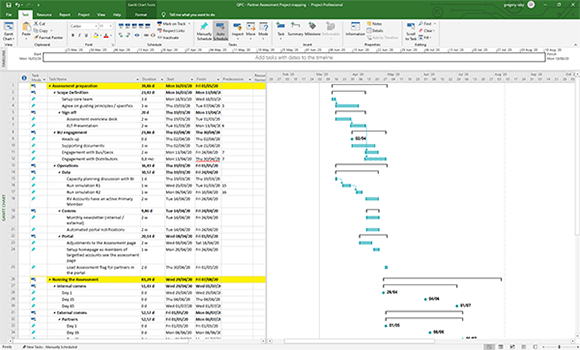Along with building a nifty partner program structure where partners can grow & thrive, partner program managers have to excel at a classic and recurring friction point: the Yearly Partner Assessment.
The Partner Assessment can be defined as a yearly exercise where vendors review their partners’ achievements against the requirements of their respective tier.
Think of it as the scalable version of your screening process at the point of onboarding.
Why are we even doing this?
Business is tough. Competition is fierce. Challenging your partners’ levels via an assessment every year seems like a poor idea to start with!
Now think of it the other way around. We all have frequent flyer membership cards, possibly with different companies or alliances. We all try to juggle with the practical details of our professional & personal trips but at times things don’t work out and you may be missing a couple of qualifying flights to retain that Gold status… You expect to be demoted to Silver but out of nowhere, you get a note saying you’re fine for this time around! Nice! Except this sets a precedent for you and for all your friends & colleagues who will ever bring the topic in a casual conversation. By not doing justice to its requirements, that airline just taught its customers it’s ok to miss the requirements, no penalty.
Next time around, if you need to pick in between two competing airlines, you’ll just go for the one which you know will keep you honest by enforcing strictly the rules they set when you joined.
You could argue that when partners throw in the towel, they may still work with you on an opportunistic basis. They may still generate revenue and close some deals. They won’t be committing on any additional online pieces of training and may become unresponsive when it’s time to submit Proofs Of Execution of a given Marketing activity. Business is business and this may simply mean the account has other priorities in mind than ticking all the boxes of your carefully drawn scorecards… But then again, chances are that they will accept the consequences of not doing so.
In my experience, what partners –VARs & Distributors particularly– tend to frown at is when you show no sign of commitment to your own program!

How to run your yearly channel partners evaluation?
There are three main phases for how you want to run your Yearly Partner Assessment: you’ll want to internally align on the scope & guiding principles, you’ll then conduct the assessment, and finally, you’ll close the exercise. It’s certainly not rocket science but it does take a little bit of practice.
A) Get your ducks in a row!
Scope
Before pulling the trigger on reviewing ALL your partner profiles in one go at any given time of your Fiscal Year, you might want to think twice and consider additional dimensions:
- Are you planning on assessing all your partner types & levels?
- If you have recently acquired a company (and onboarded its legacy partners), are they eligible?
- Two of your partners merged to become a new entity, do you want to ask them to comply right away?
- Do some partners have exceptions in place for strategic reasons?
- Do you intend to assess partners that have been promoted since your last year’s assessment?
- What is the right Fiscal Quarter to do this?
- And the list goes on based on the specific requirements of your program…
Once you’ve got a clear view of who IS/ISNOT eligible to be assessed, you’ll want to start documenting it and rallying up executive support. The ELT blessing is going to be critical once the rubber hits the road.
Operations
Chances are your CRM (salesforce & co) and your PRM (IMPartner, Zift, Salesforce and more) will need to get some attention to ensure smooth execution. Here are a few to illustrate:
- If you are using automated workflow to notify the account admins, run a quick report to check (1) there is an admin and that (2) the individual has been active in the last couple of months. Ghosts don’t read emails.
- If your portal has an assessment landing page (please tell me you do), have your Channel Account Managers review it. This is a great opportunity to prove how transparent, predictable and “Easy to do business with” your company is.
- If your distributors are acting as a proxy for you, agree with them on a template so they articulate what needs to be done for each account.
- If you find out your top partners do not have a Business Plan yet, send a simple template to their Channel Account Managers so they can engage early and have a face-to-face discussion about the partnership (and short terms goals).
Communications
If it’s done well, it speaks for itself! Spending time uphill nailing down the different dimensions of your comms is time well spent. Also, it’s an investment you can leverage every year. Some more examples:
- Internal newsletter to the Channel Account Managers (CAMs), Marketers, Operations and leadership. If possible you’d want to refer to information & content that can always be found on a dedicated landing page of your intranet)
- You want to think of CAMs and Distributors as your proxy. Prepare at least one template they can use to reach out to their partners. Maybe they know a more relevant account member than the default one in your PRM.
- Monthly summary to the leaders articulating the progress made in a very visual manner. Depending on your organizational setup and company culture you may want to segment your audience.
B) Conducting a Partner Assessment
Assuming you’ve done a fairly good job in the first phase, running the actual assessment is going to be straightforward. Regardless of how prepared you are, you will be getting questions from your CAMs, from your Distributors, from your Partners; and that’s a good as it shows you’re onto something.
To set the cadence and keep the momentum, it’s a good practice to send gentle reminders and follow-ups to your stakeholders. If you run your partner assessment over a three-month period, you’ll want to send a monthly note to (1) let them know they are being assessed, (2) keep them posted on progress made mid-way and (3) send a last reminder 3 weeks prior to the quarter-end. Sending automated emails isn’t obviously enough to really make an impact, but it’s the very minimum you should be doing to treat everyone fairly.
Going back to your list of eligible partner accounts for the assessment, you’ll want to take the top 25% and make sure you give them a call. If that turns out to be too many phone calls, get some help (CAMs or Distributors) but never rely on emails only to conduct a successful partner assessment. You want to engage as much as possible: emails, calls, vendor days with snacks… Keep in mind your competitors are doing the exact same, so every little bit helps to differentiate!
Also, this is a good opportunity to showcase some of the tools & benefits of your program.
- Short in training completions? Have you noticed all our courses got refreshed to support the latest version/release of or solution?
No budget for certifications? We do offer Marketing Development Funds to support our partners’ enablement! - Short in bookings or ARR? Have you discussed Lead Distribution with your Channel Account Manager?
- Don’t have a business plan yet? This is the right time to sit down and build a plan for the year. Engage!
C) Closing the assessment
The last chapter may only take about 2 weeks but it’ll set in stone the memory people will retain… up until next year.
- Take the time to get your final report ready. Wait for the Finance cubes to refresh so they capture the whole quarter including the usual adjustments.
- Make sure you’ve captured all the critical exceptions escalated by your business partners.
- Share the results internally first: Intranet, email communication, team calls. Once you got your teams covered, and only then, refresh your partners’ levels in your PRM when you are ready to send the final letters to your partners with a clear Call-To-Action.
Chances are your impacted partners will want to discuss the outcome of the assessment, hence the need to have your CAMs covered first.
Takeaways & download
Preparing for the assessment, executing the plan & spending time with your partners and distributors and finally winding down with a clean message is how you want to run your yearly partner assessment. It’s certainly not rocket science but it does take time to set the right goals, document clearly and raise awareness.
When done well, a yearly partner assessment is actually a great way to show how easy it is to thrive within your program, build or renew a link with your partnerships
Not all partners will maintain their partnership levels, but there are more success factors than passing the test:
- How many business plans have you managed to establish?
- How many certifications have been completed?
- How many internal sales reps have discovered and used for the first time your Lead Distribution / Lead Routing workflow?
All these points (and so many more) are actually the stigma of a better penetration of the channel in the DNA of your company and a higher share of mind within your partners.
This post is about a high level overview of how to conduct a channel partner assessment. For those who want to get to the nitty-gritty, here’s a modest Gantt diagram of the different tasks you’ll need to conduct. 

Leave a Reply